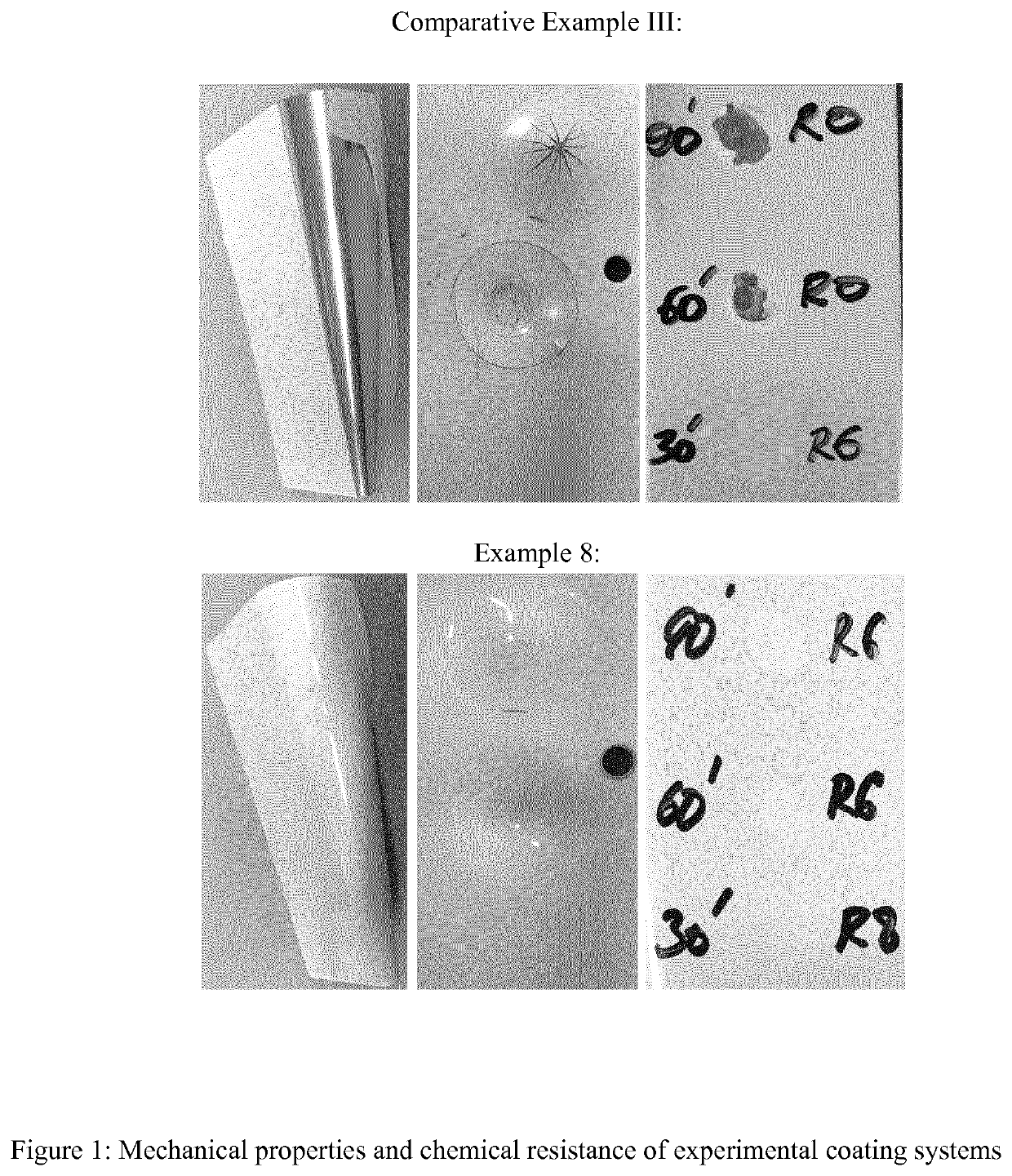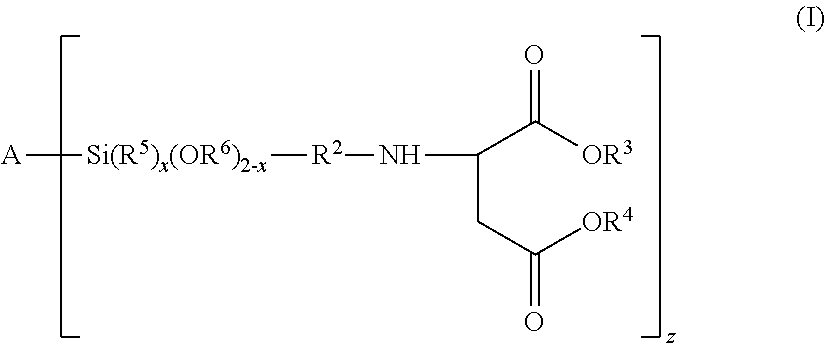Aspartic acid ester-functional polysiloxanes, their preparation and use thereof
- Summary
- Abstract
- Description
- Claims
- Application Information
AI Technical Summary
Benefits of technology
Problems solved by technology
Method used
Image
Examples
embodiment 1
[0166]A compound of the formula (I):
[0167]wherein
[0168]A is oxygen (—O—) or a polyorganosiloxanyl residue comprising at least one siloxy unit selected from the group consisting of R13SiO2, R12SiO2 / 2, R1SiO3 / 2 and SiO4 / 2, wherein R1 is an organic group and the polyorganosiloxanyl residue is bonded to Si via an oxygen atom, with the provisos that (i) if A is oxygen (—O—), then z is 2, and (ii) if A is a polyorganosiloxanyl residue, then the polyorganosiloxanyl residue contains at least two siloxy groups which can bond to the silicon atom;
[0169]each R2 is independently selected from the group consisting of a straight chain alkylene group having from 1 to 10 carbon atoms, branched chain alkylene group having from 3 to 10 carbon atoms, a cycloalkylene group having from 3 to 10 carbon atom, an arylene group having from 6 to 12 carbon atoms, an aralkylene group having from 7 to 10 carbon atoms and an arenylene group having from 7 to 10 carbon atom, preferably methylene, propylene, 2-methyl...
example 1
of Aspartic Acid Ester-Functional Polysiloxane (AEAFP-1)
[0259]4-Amino-3,3-dimethylbutyltrimethoxysilane (256 grams, 1.15 mole) was charged in a 1000-ml four neck flask, equipped with a stirrer, condenser, thermometer and a dropping funnel. Hydroxy-terminated polydimethylsiloxane (260 grams with an OH content of 4.4 mmole / gram or 1.15 mole of OH) was added to the aminosilane from the dropping funnel over 30 minutes, starting at room temperature. During the feeding the temperature increased up to 31° C. After the feeding, the mixture was heated up to 70° C. and held for 2 hours at 70° C. After that, the formed methanol was stripped out at 150° C., 20 mbar. Yield: 450 grams of a low viscous amino-functional siloxane with an amine content of 2.4 mmole N / gram, determined by titration with 1 molar hydrochloric acid. The following structure of the product (AFP-1) was confirmed by the 1H and 29Si NMR analyses.
[0260]wherein n1 is about 4 to about 8.
[0261]Amino-functional polysiloxane (AFP-1)...
example 2
of Aspartic Acid Ester-Functional Polysiloxane (AEAFP-2)
[0262]3-Aminopropyltriethoxysilane (221 grams, 1 mole, obtained from Momentive under the trade designation Silquest* A-1100 silane) was charged into a 1000 ml four neck flask, equipped with stirrer, condenser, thermometer and dropping funnel. Over the dropping funnel 260 grams of a hydroxy-terminated polydimethysiloxane with an OH content of 4.4 mmole / gram or 1.15 mole OH were added to the above aminosilane over 30 minutes, starting at room temperature. During the feeding the temperature increased up to 31° C. After the feeding, the mixture was heated up to 70° C. and held for 2 hours at 70° C. After that, the formed ethanol was stripped out at 150° C., 20 mbar. Yield: 450 grams of a low viscous amino-functional polysiloxane (AFP-2) with an amine content of 2.5 mmole N / gram, determined by titration with 1 molar hydrochloric acid. The following structure of the product (AFP-2) was confirmed by the 1H and 29Si NMR analyses.
wherei...
PUM
| Property | Measurement | Unit |
|---|---|---|
| Mass | aaaaa | aaaaa |
| Mass | aaaaa | aaaaa |
| Mass | aaaaa | aaaaa |
Abstract
Description
Claims
Application Information
 Login to View More
Login to View More - R&D
- Intellectual Property
- Life Sciences
- Materials
- Tech Scout
- Unparalleled Data Quality
- Higher Quality Content
- 60% Fewer Hallucinations
Browse by: Latest US Patents, China's latest patents, Technical Efficacy Thesaurus, Application Domain, Technology Topic, Popular Technical Reports.
© 2025 PatSnap. All rights reserved.Legal|Privacy policy|Modern Slavery Act Transparency Statement|Sitemap|About US| Contact US: help@patsnap.com



